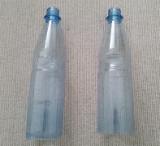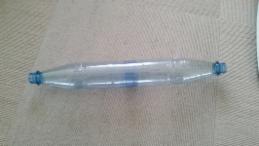Aleutenpumpe / Aleutian Suction Bailer
Die Aleutenpumpe ist ein Paradebeispiel dafür, dass die einfachsten Lösungen oftmals auch die besten sind.
The Aleutian suction bailer is a prime example that the simplest solutions are often the best.
Historisches / History
Die Eskimos (siehe Stellungnahme zu diese m Begriff am Ende) der Aleuten hatten eine Pumpe zum Lenzen ihrer Kajaks erfunden, die einhändig bedient werden kann, keine beweglichen Teile enthält und äußerst zuverlässig ist. So eine Pumpe besteht aus zwei ausgehöhlten konischen Holzteilen mit einer Länge von ungefähr 45 bis 50 cm und einem Durchmesser in der Mitte von 7 bis 8 cm. Der Inhalt liegt ungefähr bei 1 Liter. Die Pumpe wird im Kajak sitzend bedient. Die untere Öffnung wird zwischen den Beinen in das zu lenzende Wasser auf dem Boden des Kajaks gehalten. Mit dem Mund wird am anderen Ende der Pumpe das Wasser angesogen. Die untere Öffnung der Pumpe wird dann mit einem Finger verschlossen und das Wasser außenbords abgelassen. Die Pumpe wird benutzt, wenn das Wasser im Kajak so niedrig steht, dass es mit einem Ösfass' (großer Becher, kleiner Eimer, Dose und dergleichen) nicht ausgeschöpft werden kann.
m Begriff am Ende) der Aleuten hatten eine Pumpe zum Lenzen ihrer Kajaks erfunden, die einhändig bedient werden kann, keine beweglichen Teile enthält und äußerst zuverlässig ist. So eine Pumpe besteht aus zwei ausgehöhlten konischen Holzteilen mit einer Länge von ungefähr 45 bis 50 cm und einem Durchmesser in der Mitte von 7 bis 8 cm. Der Inhalt liegt ungefähr bei 1 Liter. Die Pumpe wird im Kajak sitzend bedient. Die untere Öffnung wird zwischen den Beinen in das zu lenzende Wasser auf dem Boden des Kajaks gehalten. Mit dem Mund wird am anderen Ende der Pumpe das Wasser angesogen. Die untere Öffnung der Pumpe wird dann mit einem Finger verschlossen und das Wasser außenbords abgelassen. Die Pumpe wird benutzt, wenn das Wasser im Kajak so niedrig steht, dass es mit einem Ösfass' (großer Becher, kleiner Eimer, Dose und dergleichen) nicht ausgeschöpft werden kann.
Hier eine Abbildung einer originalen Aleutenpumpe: KAYAK BAILER (II-A-3478)
In folgender Abhandlung befindet sich am Abschnitt "Equipment" eine weitere Abbildung. The Aleut Kayak As Seen By Its Builder And User And The Sea Otter Hunt. Die Angabe des Durchmessers (width) in der Bildbeschreibung ist fehlerhaft. Statt 17,8 cm muss es 7,8 cm heißen.
Wer eine originalgetreue Aleutenpumpe bauen möchte, findet hier eine Anleitung: Build an Alaskan Suction-Bailer for your Kayak
Eine andere Möglichkeit besteht darin, eine derartige Pumpe aus zwei Getränkeflaschen zu bauen. Dies wird im folgenden Abschnitt beschrieben
.
The Eskimos (see opinion on that term below) of the Aleutian islands had invented a pump for bail out their kayaks, which can be operated with one hand, contains no moving parts and is extremely reliable. The pump consists of two hollow conical timber parts with a length of about 45 to 50 cm (18 to 20 inch) and a diameter in the middle of 7-8 cm (2.8 3.1 inch). The content is approximately 1 Liter (0.22 gallons). The pump is operated while sitting in the kayak. The lower opening is held between the legs on the bottom of the kayak. With the mouth the water is sucked in at the upper end of the pump. The lower opening of the pump is then sealed with a finger and the water discharged overboard. The pump is used when the use of a bailer (great mug, small bucket, tin, etc.) is not meaningful because there is not enough water in the kayak.
Here is an illustration of an original Aleutian suction bailer: KAYAK BAILER (II-A-3478)
The following essay contains another illustration which is located under "Equipment": The Aleut kayak As Seen By Its Builder and User And The Sea Otter Hunt. The specification of the diameter (width) in the image description is erroneous. Instead of 17.8 cm (7 inches), read 7.8 cm (3.1 inches).
If you want to build an original Aleutian suction bailer, you can find instructions here: Build an Alaskan Suction-Bailer for your Kayak
Another possibility is to build such a pump from two beverage bottles. This is described in the following section.
Bau einer Aleutenpumpe aus zwei Getränkeflaschen / Construction of an Aleutian suction bailer out of two bottles
Hinweis: Die Nummerierung korrespondiert mit den Nummern der Bilder.
Man benötigt zwei 0,75 Liter Getränkeflaschen aus stabilem Kunststoff (Mehrwegflaschen). Der Kunststoff von Einwegflaschen ist so dünn, dass er dem Unterdruck, der beim Ansaugen des Wasser entsteht nachgibt. Die Länge kann man - in Grenzen - seiner eigenen Körpergröße anpassen. Der Inhalt der fertigen Pumpe liegt ungefähr zwischen 1 bis 1,3 Liter.
1. Die Böden der Flaschen werden abgesägt. Der Boden der zukünftigen inneren Flasche wird so abgesägt, dass noch etwas Bodenrundung stehen bleibt, damit die Flasche später besser in die äußere Flasche hinegeschoben werden kann.
2. Der untere Teil der inneren Flasche wird in heißes Wasser (nahezu kochend) gehalten. Dann lässt sie sich in die äußere Flasche schieben.
Hint: The numbering corresponds to the numbers of Images.
It requires two 0.75 liters (approximately 0.165 gallons) beverage bottles made of sturdy plastic (refillable bottles). The plastic of disposable bottles is so thin that it yields to the vacuum that is created when sucking the water. The length can be adapted - within limits - to your own body size. The content of the finished pump is approximately between 1 to 1.3 Liters (0.22 to 0.29 gallons).
1. The bottoms of the bottles are sawn. The bottom of the future inner bottle is sawn that a bit of the rounding of the bottom is kept. With keeping some of the rounding the inner bottle can more easyly be inserted into the outer bottle .
2. The lower part of the inner bottle is kept in hot water (almost boiling). Then it can be pushed into the outer bottle.
Pic 1 Pic 2
Pic 2
3. Nun setzt man sich in Kajaksitzhaltung auf den Boden oder besser noch in sein Kajak und schiebt die Flaschen so weit ineinander, dass die Pumpe zur eigenen Körpergröße passt und komfortabel bedient werden kann. Dann nimmt die Pumpe wieder auseinander, bestreicht die innere Flasche auf der Kontaktfläche mit Kleber, schiebt die Flaschen wieder ineinander und sichert die Verbindung zusätzlich mit Gewebeband.
In einen Deckel bohrt man ein 8 mm Loch und setzt ein Stück PVC-Schlauch mit einem Außendurchmesser von 10 mm ein (Innendurchmesser 8 mm). Der Schlauch dient als Mundstück. Mit dem Schlauch hat man zusätzlich die Möglichkeit die Pumpe zu verlängern, falls sie zu kurz sein sollte. Man kann die untere Öffnung auf dieselbe Weise verkleinern. Allerdings lässt es sich um so leichter saugen, je größer die untere Öffnung ist.
3. Now sit on the floor as you would sit in your kayak or even better sit in your kayak and push the bottles into each other until the pump fits to your body size and can be operated comfortably. Then depart the pump, sweep the inner bottle on the contact surface with adhesive, push the bottles back together and secure the connection additionally with cloth tape.
Drill an 8 mm (0.3 inchres) hole in a cover and put in a piece of PVC tubing with an outer diameter of 10 mm (0.4 inches) (internal diameter 8 mm (0.3 inches)). The tube serves as a mouthpiece. With the tube you have in addition the option to extend of the pump, if it should be too short for you. You can shrink the lower opening in the same manner. However, it is easier to suck in the water the greater the lower opening is.
Pic 3
Stellungnahme zum Begriff "Eskimo" / Opinion on the term "Eskimo"
"Eskimo", ist die Sammelbezeichnung für die indigenen Völker im nördlichen Polargebiet Zu den Eskimos zählen unter anderem: Inupiat (Nordwestalaska), Yupik (Südalaska), Inuvialuit (Mackenziegebiet), Inuit (Nord- und Nordostkanada, Grönland), Alutiiq (Aleuten). Die Bedeung des Begriffs "Eskimo" ist strittig. Mögliche Bedeutungen sind: Schneeschuhflechter oder "Menschen, die eine andere Sprache sprechen". Die früher vermutete Bedeutung "Rohfleischesser" gilt heute als widerlegt. Diese und weitere Informationen können bei Wikipedia nachgelesen werden: Eskimo
Der Begriff "Eskimo" gilt heutzutage mancherorts als politisch unkorrekt. Da der Begriff "Eskimo" jedoch im Gegensatz zu Bezeichnungen wie "Zigeuner" oder "Neger" nie abwertend verwendet wurde und es keinen adäquaten Ersatz gibt ("Inuit" ist kein Ersatz, da diese Bezeichnung nicht alle Eskimos einschließt), wird auf diesen Seiten das Wort "Eskimo" benutzt.
The Eskimo are the indigenous peoples who have traditionally inhabited the northern circumpolar region from eastern Siberia (Russia), across Alaska (United States), Canada, and Greenland. Among the Eskimos include: Inupiaq (East Alaska), Yupik (Southcentral Alaska), Inuvialuit (Mackenzie area), Inuit (northern and northeastern Canada and Greenland), Alutiiq (Aleutian islands). The mean of the term "Eskimo" is debatable. Possible meanings are: Snowshoe braider or "people who speak another language." The previously suspected meaning "raw meat eaters" is now regarded as refuted. The Information presented here is taken from German Wikipedia: DE.Eskimo.
The term "Eskimo" is considered today as politically incorrect in some places. Since the term "Eskimo" however, unlike terms such as "Gypsy" or "Nigger" has never been used pejoratively and because there is no adequate replacement ("Inuit" is not a substitute, as this designation does not include all the Eskimos), is on this pages the word "Eskimo" used.
Seite erstellt / Page created: 18 Oktober 2015
Letzte Änderung / Last Update: 24 Oktober 2015